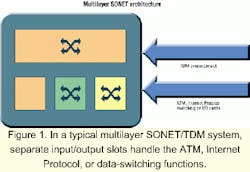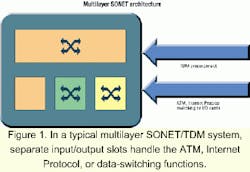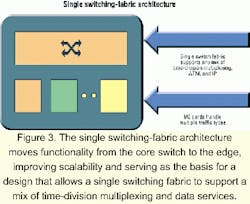Optimizing fixed-rate TDM and 'bursty' data traffic with optical access
With today's emerging optical access products, providers can use bandwidth much more effectively to generate higher revenue.
DOUG GREEN, Ocular Networks Inc.
In the search for a networking solution that makes economic sense today but also provides a base for the future, service providers face critical decisions about which new technologies to adopt. Their existing SONET systems use time-division multiplexing (TDM), a scheme in which each connection is given a fixed amount of bandwidth based on increments needed to carry a specific number of voice calls. TDM is optimized for voice traffic, but it presents a problem when carrying large amounts of data traffic. Unlike voice connections that always require the same amount of bandwidth, data connections are inherently "bursty"-they need a large amount of bandwidth at times, and very little at other times. If a TDM-based circuit is sized to carry the maximum amount of data traffic anticipated, most of that allotted bandwidth will go to waste most of the time.
New data-switching technologies work through a technique called statistical multiplexing, which combines multiple data streams to form a more stable and predictable traffic pattern. While individual streams may use widely varying amounts of bandwidth, the multiplexed stream has much less variation and therefore wastes less bandwidth. Since data is the fastest-growing segment of the market, data-switching technologies that bypass the SONET layer are an attractive alternative to TDM-based SONET systems.
The problem is that carriers derive the majority of their current revenue by delivering legacy voice and data services requiring the reliable, rigid structure TDM-based SONET provides. The mature nature of SONET standards also allows traffic to flow seamlessly across multiple carrier networks using well-understood management techniques, a capability not always available with pure data-switching technologies. As a result, TDM remains a popular basis for services carrying data as well as voice.
Because carriers need to offer both TDM and data services within the access network, the majority of emerging networking architectures use a mix of TDM and data-switching technologies to allow each to do what it does best. There are two common approaches: multilayer SONET/TDM systems and hybrid multiswitch systems.The main switching component of the multilayer SONET/TDM system is a SONET TDM-based switch, or crossconnect. This crossconnect manages traffic in fixed sizes according to the SONET hierarchy, allowing the delivery of traditional TDM-based services. At some point before the final stage of TDM processing, however, data traffic is statistically multiplexed using ATM, Internet Protocol (IP) routing, or Ethernet switching to make better use of the TDM channels. The ATM, IP, or data-switching functions are usually handled through separate I/O slots in the system (see Figure 1).
This type of system is better than a pure TDM system and an attractive alternative when most of the traffic is legacy TDM. For cases where the traffic is largely packet- or cell-based data, however, this is a very costly solution. The multiple layers of switching are very expensive when compared to pure data-switching technologies. In addition, the rigid structure of the TDM layer affects the efficiency of data switching. Further, since the data switching is designed primarily as a preprocessing stage to the TDM function, it may also be difficult to scale these systems to handle a predominantly data traffic mix. Another subtle, but substantial, drawback to these systems is that the multiple switching functions take up valuable I/O slots normally used for ports to deliver services. That means as traffic requirements grow, carriers must add more boxes to their networks, rather than just more service interface cards, to replace service capability reduced by multiple switching cards.
The multilayer SONET architecture demands that the service provider put in enough switching capacity to handle the desired mix of data versus TDM traffic. But it can be difficult to predict the optimum traffic mix-and the mix is likely to change over time. That is especially true of the rapidly evolving access network, where traffic patterns are not easily predicted and the service demands of a few customers can radically change the traffic mix. As a result, carriers need costly truck rolls to change configurations as the traffic mix changes, losing their investments in switching cards that are removed to adjust these configurations.Hybrid multiswitch architectures approach multilayer SONET issues by treating the TDM and data-switching functions as peers (see Figure 2).
In these schemes, incoming traffic is sorted at the edge of the system and directed to the appropriate switching fabric-a TDM crossconnect, an ATM switch, or an IP/packet switch. Unlike the multilayer SONET model, each protocol is carried natively and optimally within a separate system.
With extreme traffic mixes, hybrid multiswitch systems should be more efficient than multilayer SONET. At the extremes, these systems can be traffic mixes that are 100% TDM to 100% data and certain fixed increments in between, by swapping out combinations of switching fabrics. However, at intermediate traffic mixes, these systems can also be very inefficient. For instance, they may offer a fixed configuration of 75% TDM and 25% data, or 50% TDM and 50% data. Because these mixes are a function of fixed hardware, mixes that don't exactly match the percentages offered result in wasted bandwidth.
Like the multilayer SONET model, these systems also suffer from a lack of flexibility. The switching capacity must be pre-allocated among each protocol, requiring the service provider to predict the traffic mix. Any major changes in the traffic mix will result in expensive truck rolls and hardware swap-outs.
Despite these restrictions, multilayer SONET and hybrid multiswitch architectures traditionally have been the only methods of implementing emerging multiservice platforms that can carry each traffic type natively, primarily because they are easy for equipment vendors to create. Equipment vendors can buy individual, off-the-shelf switching components to handle data and TDM traffic-and they can integrate them into a system with minimal expertise in any specific technology.
For the service providers, the ideal situation would be the capability to support TDM services in their native formats as well as to statistically multiplex data using a single switching fabric within the transport system. This combination eliminates the planning issues, loss of port densities and hardware swap-outs associated with multilayer SONET and multiswitch systems. But it also requires a new approach to the design of the transport system.
Existing architectures are built on the premise that each switching system contains as much function as possible for its single intended purpose. For example, a TDM fabric performs all functions associated with TDM crossconnects, such as virtual-tributary (VT) mapping and timing and synchronization functions. Each data-switching fabric contains as much function as possible to perform routing, ATM switching, and more. While this concentration of function relieves the equipment vendor of development work, the end result is multiple specialized switching fabrics that complicate the lives of customers.
To remove this limitation, it is possible to borrow a page from the playbook of the gigabit and terabit router vendors. Most of these vendors discovered that placing all of the Layer 3 routing functionality in a centralized switch makes the system very difficult to scale. The trend in these products is to use a very simple, scalable switching, fabric as a core and perform most of the higher-level routing functions on a per-port basis, usually distributed on each I/O card.While moving functionality from the core switch to the edge is intended to improve scalability, it can also serve as the basis for a design to allow a single switching fabric to support a mix of TDM and data services (see Figure 3).
The switching fabric itself is kept simple and scalable, while the intelligence to perform crossconnect, switching, and routing functions is performed on a per-port basis, similar to the architecture used for the new generation of gigabit and terabit routers. To support TDM traffic, however, this system must support a much lower latency than that required for a packet-based fabric. The system must also add very tight timing and synchronization control across all ports to ensure the integrity of TDM traffic is maintained. Further, it must maintain a priority scheme that allows TDM traffic and high-priority data traffic to be serviced without any possibility of congestion. The combined TDM and data-switching function can be implemented with custom application-specific integrated circuits (ASICs) or a combination of ASICs and network processors, depending on the sophistication of routing functionality required. Such a system is much easier to scale, since complexity is removed from the switch fabric itself. In addition, only one switch fabric needs to be scaled rather than multiple special-purpose chips.
Although the internal design of such a system accommodates a mix of traffic types, the trick is to maintain to the outside world the characteristics of each individual function. For instance, the portion of the switching fabric allocated to TDM should appear, from a management point of view, as a TDM crossconnect-and it should support SONET standards for delay and timing parameters for crossconnects. IP packets should be transported natively-not in cell or fixed TDM format-externally to the switch fabric, as well.
The single switching-fabric system requires a unique set of engineering skills to implement. While design requirements for routers, ATM switches, and TDM crossconnects are not necessarily in conflict, they each require unique design skills to efficiently implement them. Regardless of the tradeoffs for the system vendor, the benefits to the service-provider customer are overwhelming. They are relieved of the planning, cost, and capacity issues associated with multiswitch systems. If properly designed, such a system can support any mix of traffic, from 100% TDM to 100% data-and any granularity in between-with no hardware changes whatsoever. That is especially important in the access network, where carriers are struggling to meet demand for an unpredictable mix of services.
By implementing a combination of a high-speed, simplified switching fabric with customized distributed intelligence, access systems can be built to support both TDM and native data services that support any traffic mix with no hardware changes. This architecture gives service providers the capability of addressing the pent-up demand for TDM-based services as well as high-growth and high-margin gigabit data services, without the planning and complexity issues introduced with multilayer SONET and multiswitch systems. With this solution, service providers can take the guesswork out of network planning and provisioning, instantly migrating to next-generation optical access while supporting both legacy and emerging services with low operational costs.
Doug Green is vice president of marketing at Ocular Networks Inc. (Fairfax, VA).


